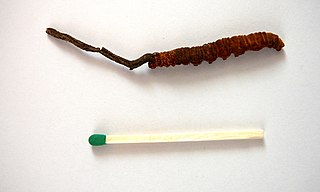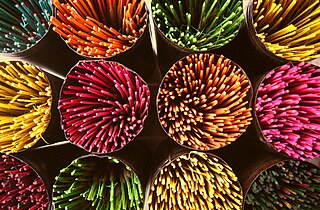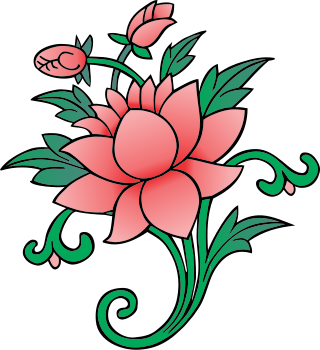
Tibetan Buddhism is a form of Buddhism practiced in Tibet, Bhutan and Mongolia. It also has a sizable number of adherents in the areas surrounding the Himalayas, including the Indian regions of Ladakh, Darjeeling, Sikkim, and Zangnan, as well as in Nepal. Smaller groups of practitioners can be found in Central Asia, some regions of China such as Northeast China, Xinjiang, Inner Mongolia and some regions of Russia, such as Tuva, Buryatia, and Kalmykia.

Vajrayāna, also known as Mantrayāna, Mantranāya, Guhyamantrayāna, Tantrayāna, Tantric Buddhism, and Esoteric Buddhism, is a Buddhist tradition of tantric practice that developed in Medieval India. Tantrism, which originated within Hinduism during the first millennium CE, significantly influenced South Asian Mahāyāna Buddhism, giving rise to distinct Buddhist tantric traditions. Emerging in the 7th century CE, these traditions spread across Southeast, East, and Central Asia, leading to distinct East Asian and Tibetan practices.

Incense is an aromatic biotic material that releases fragrant smoke when burnt. The term is used for either the material or the aroma. Incense is used for aesthetic reasons, religious worship, aromatherapy, meditation, and ceremonial reasons. It may also be used as a simple deodorant or insect repellent.

Tibetans are an East Asian ethnic group native to Tibet. Their current population is estimated to be around 7.7 million. In addition to the majority living in the Tibet Autonomous Region of China, significant numbers of Tibetans live in the Chinese provinces of Gansu, Qinghai, Sichuan, and Yunnan, as well as in Bhutan, the India, and Nepal.

Ophiocordyceps sinensis, known colloquially as caterpillar fungus, is an entomopathogenic fungus in the family Ophiocordycipitaceae. It is mainly found in the meadows above 3,500 metres (11,500 ft) on the Tibetan Plateau in Tibet and the Himalayan regions of Bhutan, India, and Nepal. It parasitizes larvae of ghost moths and produces a fruiting body which is valued in traditional Chinese medicine as an aphrodisiac. Caterpillar fungus contains the compound cordycepin, an adenosine derivative. However, the fruiting bodies harvested in nature usually contain high amounts of arsenic and other heavy metals, so they are potentially toxic and sales have been strictly regulated by China's State Administration for Market Regulation since 2016.

Nyingma can be referred to as Ngangyur, is the oldest of the four major schools of Tibetan Buddhism. The Nyingma school was founded by Padmasambhava as the first translations of Buddhist scriptures from Pali and Sanskrit into Tibetan occurred in the eighth century. The establishment of the Tibetan Buddhism and the Nyingma tradition is collectively ascribed to Khenpo Shantarakshita, Guru Padmasambhava, and King Trisong Detsen, known as Khen Lop Chos Sum.

Losar also known as Tibetan New Year, is a festival in Tibetan Buddhism. The holiday is celebrated on various dates depending on location tradition. The holiday is a new year's festival, celebrated on the first day of the lunisolar Tibetan calendar, which corresponds to a date in February or March in the Gregorian calendar. In 2024, the new year commenced on 10 February and celebrations ran until the 12th of the same month. It also commenced the Year of the Male Wood Dragon.

Lepcha language, or Róng language, is a Himalayish language spoken by the Lepcha people in Sikkim, India and parts of West Bengal, Nepal, and Bhutan.

Traditional Tibetan medicine refers to a centuries-old traditional medical system that employs a complex approach to diagnosis, incorporating techniques such as Venesection, Moxibustion, Compression Therapy, Medicinal Bathing, massage and pharmacology that relies on a complex formulary of multi-ingredient drugs that use herbs, minerals, metals, and animal products.
Semde (Tibetan: སེམས་སྡེ, Wylie: sems sde; Sanskrit: cittavarga, "mind division", "mind class" or "mind series" is the name of one of three scriptural and lineage divisions within the Dzogchen tradition. The Nyingma school of Tibetan Buddhism traditionally classifies its Dzogchen teaching into three main divisions: Semde, Longdé and Menngagde.
Longdé is the name of one of three scriptural divisions within Dzogchen, which is itself the pinnacle of the ninefold division of practice according to the Nyingma school of Tibetan Buddhism.

Hevajra is one of the main yidams in Tantric, or Vajrayana Buddhism. Hevajra's consort is Nairātmyā.

India is the world's main incense producing country, and is also a major exporter to other countries. In India, incense sticks are called Agarbatti (Agar: from Dravidian Tamil அகில், அகிர், Sanskrit varti, meaning "stick". An older term "Dhūpavarti" is more commonly used in ancient and medieval texts which encompasses various types of stick incense recipes. Incense is part of the cottage industry in India and important part of many religions in the region since ancient times. The method of incense making with a bamboo stick as a core originated in India at the end of the 19th century, largely replacing the rolled, extruded or shaped method which is still used in India for dhoop.

Ngamring County is a county of Xigazê in the Tibet Autonomous Region, China. "Ngamring County, sometimes referred to as the gateway to Mount Kailash and Far West Tibet, is the barren area which divides the Raga Tsangpo and the Brahmaputra."
Lung means wind or breath. It is a key concept in the Vajrayana traditions of Tibetan Buddhism and has a variety of meanings. Lung is a concept that is particularly important to understandings of the subtle body and the trikaya. Traditional Tibetan medicine practitioner Tamdin Sither Bradley provides a summary:
The general description of rLung is that it is a subtle flow of energy and out of the five elements it is most closely connected with air. However it is not simply the air which we breathe or the wind in our stomachs, it goes much deeper than that. rLung is like a horse and the mind is the rider, if there is something wrong with the horse the rider will not be able to ride properly. Its description is that it is rough, light, cool, thin, hard, movable. The general function of rLung is to help growth, movement of the body, exhalation and inhalation and to aid the function of mind, speech and body. rLung helps to separate in our stomachs what we eat into nutrients and waste products. However its most important function is to carry the movements of mind, speech and body. The nature of rLung is both hot and cold.
Nub་Ben Namkhai Nyingpo is counted amongst the principal "twenty-five disciples" of Padmasambhava. Nub Ben Namkha'i Nyingpo was a realized practitioner of Śāntarakṣita’s tradition of Sutrayana "gradualist" Mahayana Buddhism as well as simultaneously being one of the most accomplished Tibetan practitioners of the East Mountain Teaching of Chan Buddhism, which transmits the "subitist" tradition of Mahayana Buddhism.
Vima Nyingthig, "Seminal Heart of Vimalamitra", in Tibetan Buddhism is one of the two "seminal heart" collections of the menngagde cycle Dzogchen, the other one being "Seminal Heart of the Dakini". Traditionally the teachings are ascribed to Vimalamitra, but they were codified and collated by their Tibetan discoverers in the 11th and 12th century. The main discoverer of the Vima Nyingthig was Zhangtön Tashi Dorjé.

Nyingma Gyubum is a collection of Vajrayana texts reflecting the teachings of the Nyingma ("Ancient") school of Tibetan Buddhism.

Lhasa is noted for its historic buildings and structures related to Tibetan Buddhism. Several major architectural works have been included as UNESCO's World Heritage Sites.
Gyurme Dorje was a Scottish Tibetologist and writer.














